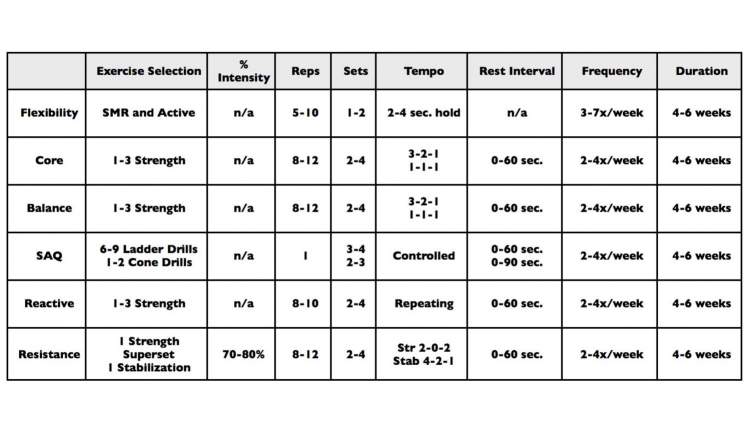Trainers, like anyone else, are creatures of habit. So it's not surprising that we can get stuck in the proverbial rut of doing the same tasks over and over again without even thinking (motor learning), eventually losing sight of, or forgetting, why we are doing things the way we do. Because of this, it is important to do a periodic self-check by asking ourselves if what we are doing is what is best for our clients, ourselves and/or our business. A simple, yet important case in point is the way in which initial training session(s) are conducted.
This column is designed to help you analyze "what it is you do" and "why," and to determine the overall quality and success of your efforts. I will present you with what I have learned over the past 15 years as a certified personal trainer and CEO of my own business. This will help you to streamline your approach and give you a scientific and progressive process to work with.
Each client starts out with a file of blank forms. How well we work with these forms will determine how successful the client is in achieving their goals. They have come to us seeking our professional assistance, knowledge and skills to help them attain the desired level of fitness. Our first job is to ensure that we obtain their full cooperation in filling out all of the necessary forms as completely as possible. Each bit of information is like a puzzle piece, and if any of the pieces are missing, we are unable to see the whole picture concerning their health, habits, nutrition, current level of fitness, and their level of commitment to make the critical changes needed to reach their goals. To make their experience as safe, meaningful and enjoyable as possible, it is imperative that we actually review all of the forms with them by essentially interviewing the new client. That gives us an opportunity to dig deeper (intrinsic motivators vs. extrinsic) than they might believe is necessary or relevant. The process is comprehensive and will take some time, but remember, knowledge IS power! The knowledge gained from these forms, and the interview process during the initial meeting, assessments, or casual conversations, etc., is critical to successfully assisting the client in achieving their goals. Only when we have gathered all of the information we need to intelligently and correctly proceed with their actual training sessions, will we do so.
Every client who begins training with me is required to complete the following 10 forms: (1) Member Information and Enrollment; (2) Informed Consent and Liability Release; (3) Medical History and PARQ; (4) Physician's Approval for Activity; (5) Monthly Payment/Auto Draft Authorization; (6) Membership Renewal and Cancellation Policies; (7) Integrated Fitness Profile; (8) Static and Dynamic Postural Assessments; (9) Redcord Assessment and (10) Strength/Performance Assessment (if applicable).
Ideally, forms 1-6 are filled out prior to the client's assessment. We have found from experience that clients, who make the time and emotional investment by completing the forms, do not cancel or even reschedule their assessments. It helps to lock in their commitment to pursue their fitness goals. After forms 1 through 6 are filled out, we complete forms 7 through 10 by doing the profile and three assessments. Our assessment process takes a total of about 2-3 hours to complete and we refer to the assessment as session 0. During the assessment we take photos and videos of the client to provide additional documentation for a better understanding of our client's status and abilities. This enables a client's ability to visually see what we are talking about when describing their posture and movement capabilities. As part of covering the results of the assessment we provide the client with a movie that depicts these photos and videos. Below is a description of each of these forms and why each one is important. (For a copy of these forms please visit our website www.catalystfitness.com. You can also email me at info@catalystfitness.com if you have any questions.)
Member Information and Enrollment: This form provides us with demographic, contact, and emergency information; their reason(s) why they are interested in beginning a fitness program; their learning style (visual, auditory or kinesthetic) and how they heard about us.
Informed Consent and Liability Release: This form explains the natural inherent risks of exercise testing and exercise(s). It also provides for the standard release of liability. In it, the client includes information about any current or previous injuries, illnesses, surgeries, disabilities, medications or limitations. This information is then factored into our decisions when developing their exercise program. Its importance cannot be emphasized strongly enough because it serves as proof of what we knew to be true at the time we created their program, and protects us if something negative happens based on their failure to inform us of the information. This form also contains a photo/video release. This is important if you plan on posting content (group photos, people working out, etc.) on social media outlets like Twitter, Facebook, and Youtube.
Medical History and PARQ: Clients fill out this form prior to arriving at their assessment. This form provides us with the details of their medical history and the valuable information that is often overlooked when asking a client how they are feeling, if they have any pain, soreness, stiffness, etc. It contains specific questions that will raise a big red flag to alert us to require a physician's approval and release to begin fitness training. This, of course, serves to protect both the client and the trainer.
Physician's Approval for Activity: This form is completed by all clients, whether or not a physician's approval is immediately required. Once it is in their file, and should it be needed, it can quickly be addressed to the appropriate caregiver. It also serves as a marketing tool because it promotes our name in a positive way by demonstrating our desire to protect the client.
Monthly Payment/Auto Draft Authorization: This form provides for automatic monthly payments for all training services selected by the client at the specified prices and on the specified date. All clients are billed in advance for their pre-scheduled training services. This not only streamlines our billing process, but also enhances the scheduling of most appointments.
Membership Renewal and Cancellation Policies: This form, typically printed on a different color of paper from the other forms, is given to the client to retain as a record of their agreement with us. It defines their responsibility to notify us in writing (via email) 30 days in advance to cancel or modify their membership and training package. By requiring the written advance notice for cancellation, our bottom line is better protected, and provides us with the opportunity, should the need arise, to discuss any personal issues or reasons a client might have to abruptly or prematurely stop their training sessions. We have found many times that simple adjustments to schedules, packages or billing can enable a client to remain in training.
Integrated Fitness Profile: The following four forms are filled out by the trainer during the assessment. The Integrated Fitness Profile contains many of the same questions and information that is contained in the Medical History and PARQ form that the client filled out, but are purposely worded in a slightly different way in order to illicit different responses. By going over this information again, we always uncover some piece of useful information that the client initially left off of their paperwork.
Static and Dynamic Postural Assessments: The purpose of this form and these tests is to document and understand our observations regarding the length tension relationships. Understanding these length tension relationships requires us to view the body in static and dynamic (gait, OH or SL squat, balance excursion, etc) formats.
Redcord Assessment: Using Redcord and the numerical grading scale associated with it, we can integrate both static and dynamic postural assessments to best determine which myofascial lines are problematic (weak/underactive).
Strength and/or Performance Assessment: This form is only used when applicable, as not all clients who walk through your doors need to have a Strength or Performance Assessment performed. The type of client and what their training goals are determines the types of tests used.
With the remaining time we teach the client their first homework assignment, which consists of performing (daily) myofascial compression techniques. We also provide the client with both a DVD download and PDF printable version of each of the techniques assigned. We cover this material again at their first session to ensure that their technique is flawless.
Their next session (Session 1) is used to review the MCT's taught during the assessment and to help the client to become more aware of their body alignment and the specific protocols. After "rolling out," it is time to further engage the nervous system with balance techniques, raise the heart rate with locomotion progressions, and prepare the body for movement in all planes. This is what is referred to as movement prep. Gone are the days of "go hop on the treadmill for 5-10 minutes" to warm-up. The educated trainer plans a movement prep series of exercises specifically designed to meet the specific demands of that client for that session. In an upcoming articles, I will delve deeper into the components of movement prep.
Implementing this evidenced-based, systematic, and scalable approach to personal training clearly separates the "trainer" from the fitness professional who offers personal training as a service. By the very nature of the detailed process of gathering your client's information via the forms, taking the time to conduct a thorough assessment, and thoroughly teaching your client what they need to know about movement preparation, you provide your client with the understanding and awareness that you are a true fitness professional, who is actively engaged in successfully achieving their fitness goals. As a result, my clients respond by making their fitness training a permanent lifestyle commitment.
Valorie Ness is CEO of Catalyst Fitness Midtown located in Atlanta, Georgia. She has been in the industry for over 15 years and travels nationally and internationally as an educator and Presenter. Valorie is the 2013 PFP Trainer of the Year, Master Trainer for ACE, Red Cord and Catalyst Fitness. www.catalystfitness.com
This column is designed to help you analyze "what it is you do" and "why," and to determine the overall quality and success of your efforts. I will present you with what I have learned over the past 15 years as a certified personal trainer and CEO of my own business. This will help you to streamline your approach and give you a scientific and progressive process to work with.
Each client starts out with a file of blank forms. How well we work with these forms will determine how successful the client is in achieving their goals. They have come to us seeking our professional assistance, knowledge and skills to help them attain the desired level of fitness. Our first job is to ensure that we obtain their full cooperation in filling out all of the necessary forms as completely as possible. Each bit of information is like a puzzle piece, and if any of the pieces are missing, we are unable to see the whole picture concerning their health, habits, nutrition, current level of fitness, and their level of commitment to make the critical changes needed to reach their goals. To make their experience as safe, meaningful and enjoyable as possible, it is imperative that we actually review all of the forms with them by essentially interviewing the new client. That gives us an opportunity to dig deeper (intrinsic motivators vs. extrinsic) than they might believe is necessary or relevant. The process is comprehensive and will take some time, but remember, knowledge IS power! The knowledge gained from these forms, and the interview process during the initial meeting, assessments, or casual conversations, etc., is critical to successfully assisting the client in achieving their goals. Only when we have gathered all of the information we need to intelligently and correctly proceed with their actual training sessions, will we do so.
Every client who begins training with me is required to complete the following 10 forms: (1) Member Information and Enrollment; (2) Informed Consent and Liability Release; (3) Medical History and PARQ; (4) Physician's Approval for Activity; (5) Monthly Payment/Auto Draft Authorization; (6) Membership Renewal and Cancellation Policies; (7) Integrated Fitness Profile; (8) Static and Dynamic Postural Assessments; (9) Redcord Assessment and (10) Strength/Performance Assessment (if applicable).
Ideally, forms 1-6 are filled out prior to the client's assessment. We have found from experience that clients, who make the time and emotional investment by completing the forms, do not cancel or even reschedule their assessments. It helps to lock in their commitment to pursue their fitness goals. After forms 1 through 6 are filled out, we complete forms 7 through 10 by doing the profile and three assessments. Our assessment process takes a total of about 2-3 hours to complete and we refer to the assessment as session 0. During the assessment we take photos and videos of the client to provide additional documentation for a better understanding of our client's status and abilities. This enables a client's ability to visually see what we are talking about when describing their posture and movement capabilities. As part of covering the results of the assessment we provide the client with a movie that depicts these photos and videos. Below is a description of each of these forms and why each one is important. (For a copy of these forms please visit our website www.catalystfitness.com. You can also email me at info@catalystfitness.com if you have any questions.)
Member Information and Enrollment: This form provides us with demographic, contact, and emergency information; their reason(s) why they are interested in beginning a fitness program; their learning style (visual, auditory or kinesthetic) and how they heard about us.
Informed Consent and Liability Release: This form explains the natural inherent risks of exercise testing and exercise(s). It also provides for the standard release of liability. In it, the client includes information about any current or previous injuries, illnesses, surgeries, disabilities, medications or limitations. This information is then factored into our decisions when developing their exercise program. Its importance cannot be emphasized strongly enough because it serves as proof of what we knew to be true at the time we created their program, and protects us if something negative happens based on their failure to inform us of the information. This form also contains a photo/video release. This is important if you plan on posting content (group photos, people working out, etc.) on social media outlets like Twitter, Facebook, and Youtube.
Medical History and PARQ: Clients fill out this form prior to arriving at their assessment. This form provides us with the details of their medical history and the valuable information that is often overlooked when asking a client how they are feeling, if they have any pain, soreness, stiffness, etc. It contains specific questions that will raise a big red flag to alert us to require a physician's approval and release to begin fitness training. This, of course, serves to protect both the client and the trainer.
Physician's Approval for Activity: This form is completed by all clients, whether or not a physician's approval is immediately required. Once it is in their file, and should it be needed, it can quickly be addressed to the appropriate caregiver. It also serves as a marketing tool because it promotes our name in a positive way by demonstrating our desire to protect the client.
Monthly Payment/Auto Draft Authorization: This form provides for automatic monthly payments for all training services selected by the client at the specified prices and on the specified date. All clients are billed in advance for their pre-scheduled training services. This not only streamlines our billing process, but also enhances the scheduling of most appointments.
Membership Renewal and Cancellation Policies: This form, typically printed on a different color of paper from the other forms, is given to the client to retain as a record of their agreement with us. It defines their responsibility to notify us in writing (via email) 30 days in advance to cancel or modify their membership and training package. By requiring the written advance notice for cancellation, our bottom line is better protected, and provides us with the opportunity, should the need arise, to discuss any personal issues or reasons a client might have to abruptly or prematurely stop their training sessions. We have found many times that simple adjustments to schedules, packages or billing can enable a client to remain in training.
Integrated Fitness Profile: The following four forms are filled out by the trainer during the assessment. The Integrated Fitness Profile contains many of the same questions and information that is contained in the Medical History and PARQ form that the client filled out, but are purposely worded in a slightly different way in order to illicit different responses. By going over this information again, we always uncover some piece of useful information that the client initially left off of their paperwork.
Static and Dynamic Postural Assessments: The purpose of this form and these tests is to document and understand our observations regarding the length tension relationships. Understanding these length tension relationships requires us to view the body in static and dynamic (gait, OH or SL squat, balance excursion, etc) formats.
Redcord Assessment: Using Redcord and the numerical grading scale associated with it, we can integrate both static and dynamic postural assessments to best determine which myofascial lines are problematic (weak/underactive).
Strength and/or Performance Assessment: This form is only used when applicable, as not all clients who walk through your doors need to have a Strength or Performance Assessment performed. The type of client and what their training goals are determines the types of tests used.
With the remaining time we teach the client their first homework assignment, which consists of performing (daily) myofascial compression techniques. We also provide the client with both a DVD download and PDF printable version of each of the techniques assigned. We cover this material again at their first session to ensure that their technique is flawless.
Their next session (Session 1) is used to review the MCT's taught during the assessment and to help the client to become more aware of their body alignment and the specific protocols. After "rolling out," it is time to further engage the nervous system with balance techniques, raise the heart rate with locomotion progressions, and prepare the body for movement in all planes. This is what is referred to as movement prep. Gone are the days of "go hop on the treadmill for 5-10 minutes" to warm-up. The educated trainer plans a movement prep series of exercises specifically designed to meet the specific demands of that client for that session. In an upcoming articles, I will delve deeper into the components of movement prep.
Implementing this evidenced-based, systematic, and scalable approach to personal training clearly separates the "trainer" from the fitness professional who offers personal training as a service. By the very nature of the detailed process of gathering your client's information via the forms, taking the time to conduct a thorough assessment, and thoroughly teaching your client what they need to know about movement preparation, you provide your client with the understanding and awareness that you are a true fitness professional, who is actively engaged in successfully achieving their fitness goals. As a result, my clients respond by making their fitness training a permanent lifestyle commitment.
Valorie Ness is CEO of Catalyst Fitness Midtown located in Atlanta, Georgia. She has been in the industry for over 15 years and travels nationally and internationally as an educator and Presenter. Valorie is the 2013 PFP Trainer of the Year, Master Trainer for ACE, Red Cord and Catalyst Fitness. www.catalystfitness.com















